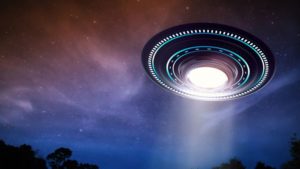
People observe strange phenomena, even though their existence cannot be proven.
Much of the UFO literature, however, focuses mainly on proving whether or not space aliens and strange phenomena are true. UFOs are either completely disputed, or the authors try to convince their readers of their existence.
The work Riddles from Space, edited by Jaakko Närvä and Jussi Sohlberg , approaches the subject from a different point of view. The authors treat UFOs and UFO experiences in particular as a religious phenomenon.
Both Närvä and Sohlberg have a background in theology. Närvä has a doctorate in philosophy from UFOs, and Sohlberg works as a coordinator specializing in neo-spirituality and new religious movements at the Church Research Center. Of the other seven writers, many are theologians.
The authors’ experience with research is conveyed in a positive way. The very first chapter sums up the history of the UFO word and experience accurately but easily.
Name of the UFO stands for unidentifable flying object , unidentified flying object. However, UFO sightings are not limited to experiences of flying saucers and nocturnal light phenomena, but some people also say they have encountered aliens in outer space. Some experiences, such as the UFO abductions, are quite wild, and the stories received attention especially in the last millennium.
The authors smoothly transport the subject from the observations of flying saucers to the attitudes of Finns. Even two out of three Finns consider it possible, at least to some extent, that UFOs are spacecraft from other worlds.
Experiences based on faith
The work deliberately does not take a position on whether UFOs exist. This can be read as either a merit or a disadvantage. Admittedly, the mere fact that UFO sightings are viewed specifically as a phenomenon similar to religious experiences may affect the reader’s interpretation.
Some of the UFO observations are very difficult to explain. The authors go through a wide range of factors that may influence the emergence of such experiences.
Was it possibly mass psychosis? Did the UFO stubbornly want to see something he didn’t actually see? Or was the experience a mere scam? Is it possible that an authority figure who strongly believes in UFOs will convince others of the authenticity of a flying saucer?
The awkwardly explained findings form the core story of a hobby similar to religious experiences, the book suggests. What makes religious experiences simplified is that narrators believe in UFOs, even though they have nothing but their own experience.
The existence of UFOs cannot be proved like that of angels, but humans see both.
Based on the figures presented in the book, the majority of UFO observations are in no way related to mental health disorders. This, too, supports the idea that UFO experiences resemble religious experiences as a phenomenon.
A mixed group of enthusiasts
The differences between UFO enthusiasts are described in an interesting way.
There are clearly religious UFOs like Mormons. Their religion inextricably includes the idea of life on other planets.
On the other hand, there are also people in UFO enthusiasts who seek to study their observations through scientific means and often use the name ufologist for themselves.
Admittedly, the authors point out that when ufologists try to rationalize their observations and describe them pseudo-scientifically, they may in fact be involved in creating a common mythology for UFO enthusiasts. This can be compared to the fact that creationists seek to explain by scientific means the belief that the earth is only about 6,000 years old. However, they do so clearly for religious reasons.
In places, the book scorches. For example, the chapter on UFO sightings as a psychological phenomenon focuses mainly on how, for example, perspective or weather conditions may make things familiar per se look strange. The section goes through the ideas of Sigmund Freud and Carl Gustav Jung , which, however, are quite outdated. Unfortunately, the reader will miss the chapter for more explanations, especially provided by modern psychology.
Psychology and sensory perceptions are still more of a sideline, and the main theme, or religiosity, carries well.
Destruction threatens the world
The second half of the work deals with, for example, the differences and similarities between Christianity and UFO hardness.
While Christianity and UFO hobby may suddenly seem far apart, Riddles from Space reveals many things they have in common.
The authors fascinately compare, for example, how Christians and those who believe in UFO contact are united by the hope of some higher power of the future. This higher power, be it Jesus or a group of advanced strangers, releases humanity from evil and corrects the problem of suffering.
Finnish UFO hardness also receives detailed treatment. The authors describe how the Swiss Erich von Däniken fooled Finns in the 1970s. His popular works told of ancient aliens.
In Finland, too, some ardent believers considered strange light phenomena and flying saucers as signs of the end times and the approach to the end of the world decades ago.
The authors also show how Christianity’s perception of the apocalypse has shifted to popular culture and especially UFO films. The basic plot of the Christian apocalypse has stuck to catastrophic films in which superior power from outside the earth threatens to destroy the entire world.
Man sees like
Although the religiosity of the UFO hobby is the main theme of the work, the epilogue approaches the subject from a slightly different perspective. In it, Saara Reiman, who is familiar with the philosophy of space exploration, writes about the nature and relationship of as yet undiscovered outer space organisms as rationally as possible.
Reiman wonders why people who believe in UFOs always see humanoids that are roughly the same size and look as ourselves. It can be an existential horror – that we are all alone in an incomprehensibly vast universe. A person may also need to think of a foreign intellect as something like ours. After all, we often associate human traits with animals.
Overall, Riddles of Space is a fascinating book. It is relatively short, but includes information on a strongly divisive issue in a comprehensive and neutral way.
If you are interested in the history of strange observations, the mind movements of the UFO hardmen, or the religious features of the hobby, the book provides a good overview of the complex phenomenon.











